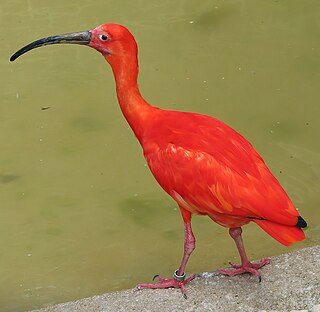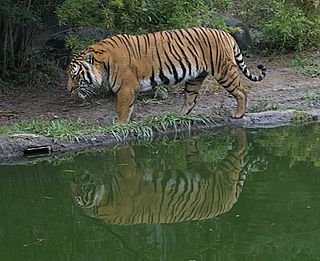
The ibis are a group of long-legged wading birds in the family Threskiornithidae that inhabit wetlands, forests and plains. "Ibis" derives from the Latin and Ancient Greek word for this group of birds. It also occurs in the scientific name of the cattle egret mistakenly identified in 1757 as being the sacred ibis.

Spoonbills are a genus, Platalea, of large, long-legged wading birds. The spoonbills have a global distribution, being found on every continent except Antarctica. The genus name Platalea derives from Ancient Greek and means "broad", referring to the distinctive shape of the bill. Six species are recognised, which although usually placed in a single genus have sometimes been split into three genera.

The family Threskiornithidae includes 36 species of large wading birds. The family has been traditionally classified into two subfamilies, the ibises and the spoonbills; however recent genetic studies have cast doubt on this arrangement, and have found the spoonbills to be nested within the Old World ibises, and the New World ibises as an early offshoot.

The cattle egret (Bubulcus) is a cosmopolitan genus of heron found in the tropics, subtropics, and warm-temperate zones. According to the IOC bird list, it contains two species, the western cattle egret and the eastern cattle egret, although some authorities regard them as a single species. Despite the similarities in plumage to the egrets of the genus Egretta, it is more closely related to the herons of Ardea. Originally native to parts of Asia, Africa, and Europe, it has undergone a rapid expansion in its distribution and successfully colonised much of the rest of the world in the last century.

The white-shouldered ibis is a large species of bird in the family Threskiornithidae. It is native to small regions of Southeast Asia, and is considered to be one of the most threatened bird species on this part of the continent.

The giant ibis is a wading bird of the ibis family, Threskiornithidae. It is confined to northern Cambodia, with a few birds surviving in extreme southern Laos and a recent sighting in Yok Đôn National Park, Vietnam. It is sometimes placed in the genus Thaumatibis.

The small bird genus Geronticus belongs to the ibis subfamily Threskiornithinae. Its name is derived from the Greek gérontos in reference to the bald head of these dark-plumaged birds; in English, they are called bald ibises.

The green ibis, also known as the Cayenne ibis, is a wading bird in the ibis family Threskiornithidae. It is the only member of the genus Mesembrinibis.

The red-naped ibis also known as the Indian black ibis or black ibis is a species of ibis found in the plains of the Indian Subcontinent. Unlike other ibises in the region it is not very dependent on water and is often found in dry fields a good distance away from water. It is usually seen in loose groups and can be told by the nearly all dark body with a white patch on the shoulder and a bare dark head with a patch of crimson red warty skin on the crown and nape. It has a loud call and is noisy when breeding. It builds its nest most often on the top of a large tree or palm.

Threskiornis is a genus of ibises, wading birds of the family Threskiornithidae. They occur in the warmer parts of the Old World in southern Asia, Australasia and Sub-Saharan Africa. They are colonial breeders, which build a stick nest in a tree or bush and lay two to four eggs. They occur in marshy wetlands and feed on various fish, frogs, crustaceans and insects. In English, they are called sacred ibises. In Australia, urban dwelling ibises are known colloquially as "bin chickens".

The hadeda ibis is an ibis native to Sub-Saharan Africa. It is named for its loud three to four note calls uttered in flight especially in the mornings and evenings when they fly out or return to their roost trees. Although not as dependent on water as some ibises, they are found near wetlands and often live in close proximity to humans, foraging in cultivated land and gardens. A medium-sized ibis with stout legs and a typical down-curved bill, the wing coverts are iridescent with a green or purple sheen. They are non-migratory but are known to make nomadic movements in response to rain particularly during droughts. Their ranges in southern Africa have increased with an increase in tree cover and irrigation in human-altered habitats.

William Ruxton Davison was a British ornithologist and collector. Davison was born in Burma but grew up mainly in Ootacamund in southern India. He worked as a private collector and museum curator for Allan Octavian Hume before taking up a position in 1887 as the first director of Raffles Museum in Singapore. He is thought to have committed suicide by opium overdose.

The wildlife of Laos encompasses the animals and plants found in the Lao People's Democratic Republic, a landlocked country in southeastern Asia. Part of the country is mountainous and much of it is still clad in tropical broadleaf forest. It has a great variety of animal and plant species.

The Madagascar ibis, also known as the Madagascar crested ibis, white-winged ibis or crested wood ibis, is a medium-sized, brown-plumaged ibis. It has bare red orbital skin, yellow bill, red legs, white wings and its head is partially bare with a dense crest of green or gloss blue and white plumes on the nape. The Madagascar ibis is the only member of the genus Lophotibis.

The dusky eagle-owl is an owl species in the family Strigidae that is widespread in South and Southeast Asia. The type specimen used to describe the species was collected on the Coromandel Coast, which was used for the specific epithet. It is listed as Least Concern on the IUCN Red List. The species's extent of occurrence is estimated at 9,250,000 km2 (3,570,000 sq mi). However, volunteer generated databases such as eBird.org suggest that the available extent of occurrence is a vast over-estimate.

Plegadis is a bird genus in the family Threskiornithidae. The genus name derives from Ancient Greek plegados, "sickle", referring to the distinctive shape of the bill. Member species are found on every continent except Antarctica as well as a number of islands. The glossy ibis is easily the most widespread of the three species. Plegadis contains the following three species:

The black-faced ibis is a species of bird in the family Threskiornithidae. It is found in grassland and fields in southern and western South America. It has been included as a subspecies of the similar buff-necked ibis, but today all major authorities accept the split. The black-faced ibis also includes the Andean ibis as a subspecies. Some taxonomic authorities still do so.
P. gigantea may refer to:

People Resources and Conservation Foundation (PRCF) is an international non-governmental organization that helps local people in developing countries protect their natural environment. Its headquarters are in the United States but its conservation fieldwork is carried out in a number of Southeast Asian countries. PRCF has joined collaborative research projects on new animal species in Southeast Asia, such as the Myanmar/Burmese snub-nosed monkey. The organization also sets up programs to help native cultures retain their cultural identity through projects such as basket and fabric weaving.
Stung Sen is a protected multiple use management area and wildlife sanctuary in the Kampong Thom Province of Cambodia. It is located near the south-eastern tip of the Tonlé Sap, one of three wildlife sanctuaries around the lake, including Boeng Tonlé Chhmar and Prek Toal.




















